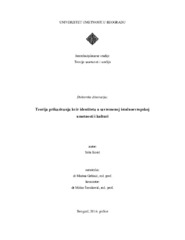Teorija prikazivanja kvir identiteta u savremenoj istočnoevropskoj umetnosti i kulturi
doktorska disertacija
Metapodaci
Prikaz svih podataka o zapisuDoktorand:
Kesić, SašaFakultet:
Интердисциплинарне студије Универзитета уметностиDatum odbrane:
02-09-2016Mentor:
- Gržinić, Marina
- Šuvaković, Miodrag
Članovi komisije:
- Todorović, Jelena
- Rosić, Tatjana
- Nikolić, Sanela
Sažetak
Diskurzivni okvir iz kog pristupam teoretizaciji prikazivanja kvir identiteta u savremenoj
istočnoevropskoj umetnosti i kulturi baziran je, u najvećoj meri, na kvir teoriji, ali i na teoriji
bio/nekropolitike. Kako bih došao do analize postsocijalističkih kvir identiteta, što je i
osnovna tema moje disertacije, poći ću, očekivano, od istorije kvira na Zapadu – kao
antiheteronormativnog ali i antihomonormativnog pokreta. Cilj prvog dela disertacije, tako,
biće da pokažem kako je, posredstvom kvira, tačka gledanja na svaki identitet
antiesencijalistička, odnosno kako je svaki identitet performativan. Predmet rasprave u
drugom delu činiće taktike pomoću kojih globalni kapitalizam, u zemljama Prvog sveta,
„prevodi“ kvir iz biopolitičke u nekropolitičku sferu, posredstvom AIDS-a, ali ga i „vraća
nazad“ radi potreba svog tržišta. Centralna rasprava, stoga, odnosiće se na potencijal kvira da
se, tokom epidemije AIDS-a koja nastupa tek nekih desetak godina nakon „kvir oslobađanja“ i
...
nastanka prajda kao zone novih mogućnosti, ne „utopi“ u neoliberalni talas
homonormativizma. Potom, oslanjajući se pre svega na postsocijalističku paradigmu Marine
Gržinić, analiziraću način na koji se kvir identiteti formiraju i afirmišu u savremenoj Istočnoj
Evropi. Centralna rasprava u ovom delu doktorske disertacije odnosiće se na kritičku analizu
odnosa između kvira i evropskih društava u tranziciji. U četvrtom delu, na osnovu prethodno
iznetih hipoteza i analiza, razmotriću revolucionarnost postsocijalističkog kvir identita u: (1)
filmu, (2) aktivizmu, (3) performansu, i (4) video instalaciji. Cilj ovog dela disertacije biće
ispitivanje mogućnosti subverzivnog delovanja, prvenstveno u vizuelnim umetnostima, ali i
aktivizmu. Konačno, u završnom razmatranju, aktikulisaću svoju centralnu tezu o vidljivosti
kvir identiteta sa trenutnom političkom situacijom, pre svega u Srbiji, 2016. godine.
Discursive framework from which I approach the theoretization of queer identity’s
representations in contemporary East European art and culture, is primarily based on the
queer theory, but also on the theory of bio/necropolitics. In order to analyze postsocialistic
queer identities, which is the main topic of my dissertation, I will start from the queer history
on the West – as anti-heteronormative but also anti-homonormative movement. The aim of
the first part of the dissertation is to show how, thanks to queer, point of view to any identity
is anti-esencialistic, ie. that every identity is porformative. In the second part of the thesis I
will introduce tactics by which global capitalism, in First world countries, moves queer from
biopolitical to necropolitical sphere, by virtue of AIDS, but also moves it back by reasons of it
market's needs. My central discussion, thus, bilds on the queer's potential to not become a part
of neoliberal wave of homonormativity, during the AID...S epidemic which started only one
decade after “queer liberation”. Then, referring primarily to Marina Gržinić postsocialistic
paradigm, I will analyze ways in which queer identities are formed in contemporary East
Europe. The central debate in this part of disertation will relate to the critic analysis of the
relationship between the queer and European societies in transition. In the fourth part of my
thesis, according to the above stated hypothesis, I will consider queer identity's revolutionary
in the: (1) film, (2) activism, (3) performance, and (4) video intalation. The aim of this part of
my disertation is the examination of the possibility of subversive action, primarily in visual
arts, but also in activism. Finally, in the closing discussion, I will articulate my central thesis
about queer identities visibility with the contemporary political situation, primarily in Serbia,
in 2016.

